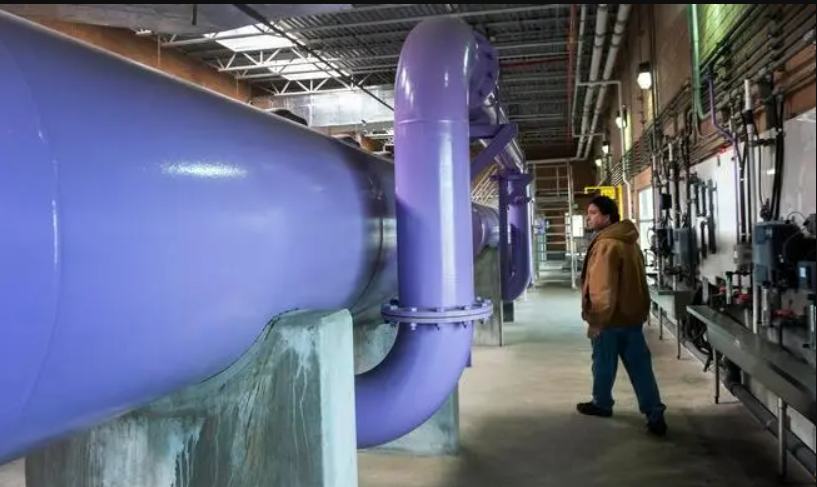The West’s rising thirst for water is driving a push in Colorado, home of pristine mountain snowfields, to do more with dirty H2O.
Denver’s City Council this month initiated citywide efforts to reuse sewer-bound shower and laundry “gray water” — by redirecting it to flush toilets and to provide water for subsurface drip irrigation of gardens.
Denver Water has expanded use of partially treated municipal wastewater, a different class of water, recycling 2 billion gallons a year through a growing 68-mile underground network of “purple pipes” to maintain greenspace.
And for sewage in general, a proposed experimental treatment plant in the south suburbs would deploy filters, chemicals and close monitoring to clean wastewater to where people could drink it again — and again in a continuous loop.
It makes sense for Colorado to become a center for solving water problems, said James Eklund, director of the Colorado Water Conservation Board and architect of a plan to deal with the state’s projected 163 billion-gallon shortfall.
“Reuse isn’t just an important Colorado opportunity, but it’s a vital regional, national and global opportunity,” Eklund said. “As the headwaters state to 18 downstream states and Mexico, Colorado is in prime position to be a leader of water innovation in areas like reuse.”
The Colorado Water Plan calls for increased water conservation, cutting consumption by 400,000 acre-feet a year (130 billion gallons), to help deal with population growth and development pressures on water. It also urges reuse — extending the life of existing water supplies — with a target of reusing 61,000 acre-feet a year (19 billion gallons) by 2050.
But hurdles remain.
Plumbing costs remain uncertain, both for retrofitting existing buildings and for new construction.
And Denver residents have complained that the recycled partially treated wastewater may be killing pine trees in Washington Park. Denver Zoo officials this year discontinued use of recycled water for its elephants to drink.
Denver Water officials are wrestling with this, saying recycled water in purple pipes is as fully treated as drinking water was in the early 1980s, insisting it should be fine for irrigating parks. They’ve formed a committee with residents.
The problem: Recycled water, because it once contained urine, holds salts that would be costly to remove. It is different from gray water, which is household wastewater that has not yet moved into sewers.
“Sodium can be a stressor for some non-native trees, but it is difficult to determine one specific cause that impacts tree health,” Denver Water spokeswoman Stacy Chesney said. “If we were to add to the treatment cost, we would have to pass that cost on to our customers.
“Salinity is very costly and energy-intensive to remove at the treatment facility. The processes that would need to be implemented would basically make (Denver’s recycled water) plant a potable-water facility, which defeats the purpose of reusing water for non-drinking purposes.”
Denver Water has been expanding its delivery of recycled water — an alternative to diverting more water from mountain rivers — now reaching more than 80 locations. Nine Denver schools, 34 parks, five golf courses, the zoo, businesses and home associations rely on the partially treated wastewater. The Denver Museum of Nature & Science uses it to run heating and cooling systems, and Xcel Energy uses it in cooling towers at its Cherokee power plant in Adams County.
For gray-water reuse, the Colorado Department of Public Health and Environment is supporting efforts to meet the state goals while also trying to make sure water redirected for toilet-flushing and drip irrigation of gardens doesn’t expose people to pathogens.
“Research indicates that gray water contains human pathogens,” CDPHE spokeswoman Meghan Trubee said. “Waterborne diseases have the ability to transmit through many risk pathways that can be associated with gray-water uses.”
A 2013 state law that legalized reuse of gray water directed CDPHE officials to make rules. These rules require municipalities to make their own rules and establish controls, including reviews of installed systems, inspections and tracking gray water.
Denver this month became the first city to move forward. Council members decided unanimously, in a committee hearing, to develop designs and rules for citywide tapping of gray water. This would require replumbing buildings and homes where owners are interested and installing the latest dual piping in new buildings. The statewide plumbing code was updated last year to embrace gray-water reuse.
“You would use this water more than once before it goes back into the municipal system,” Denver Environmental Health scientist Jon Novick said. “Instead of wasting resources, you’d be using perfectly usable water twice.”
Denver City Councilwoman Robin Kniech welcomed the efforts to reuse shower and laundry, saying this fits with Denver’s vibe as an environmentally forward-moving place.
“Sometimes our reputation gets ahead of us,” Kniech said.
Other Colorado cities and towns are considering recycling and reusing gray water.
Water industry leaders, meanwhile, are considering metro Denver as the site for a pilot project to showcase water-cleaning and monitoring technology aimed at purifying wastewater as a new source of drinking water.
Western Resource Advocates water expert Laura Belanger, president of WateReuse Colorado, said enthusiasm is high. And water providers have lined up $300,000 to develop plans for water reuse statewide.
“Water is so expensive right now,” Belanger said. “It is extremely difficult to acquire new water supplies. And if a community can use water more than once, that’s a big benefit.
“Then you don’t have to go out and acquire new supplies. There’s just not that much extra water out there anymore. We will have to be creative and adapt.”

